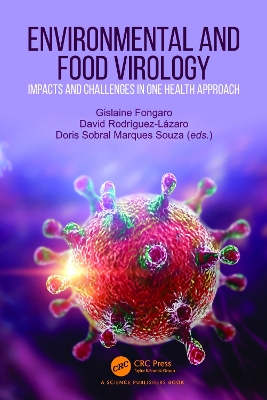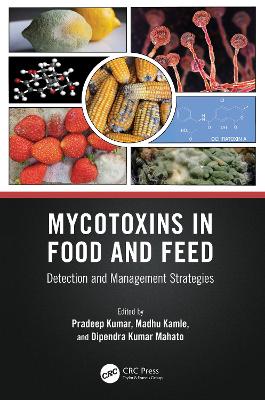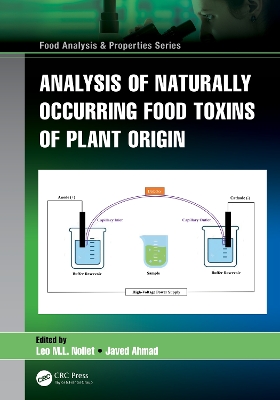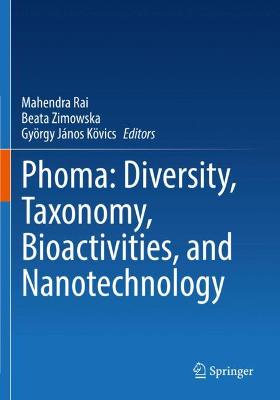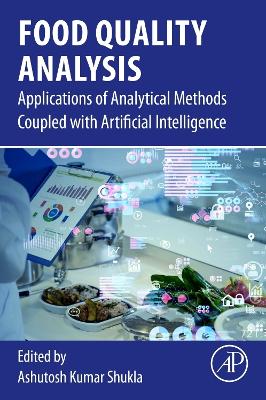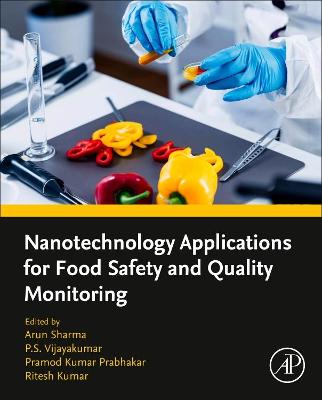Present Knowledge in Food Safety
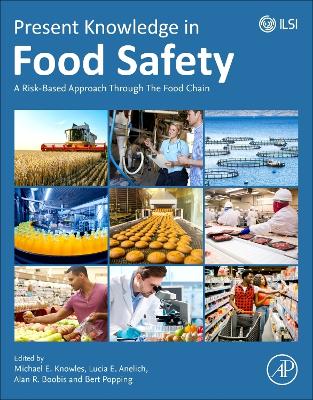 portes grátis
portes grátis
Present Knowledge in Food Safety
A Risk-Based Approach Through the Food Chain
Boobis, Alan; Knowles, Michael E.; Popping, Bert; Anelich, Lucia
Elsevier Science Publishing Co Inc
10/2022
1188
Mole
Inglês
9780128194706
15 a 20 dias
3150
Section II Changes in the chemical composition of food throughout the various stages of the food chain: animal and milk production 5. Occurrence of antibacterial substances and coccidiostats in animal feed Ewelina Patyra, Monika Przenioslo-Siwczynska and Krzysztof Kwiatek 6. Residues relating to the veterinary therapeutic or growth promoting use and abuse of medicines Gyorgy Csiko
Section III Changes in the chemical composition of food throughout the various stages of the food chain: fishing and aquaculture 7. Marine biotoxins as natural contaminants in seafood: European perspective Pablo Estevez, Jose M. Leao and Ana Gago-MartinezGago 8. Pollutants, residues and other contaminants in foods obtained from marine and fresh water Martin Rose 9. Antimicrobial drugs in aquaculture: use and abuse George Rigos and Dimitra Kogiannou
Section IV Changes in the chemical composition of food throughout the various stages of the food chain: manufacture, packaging and distribution 10. Manufacturing and distribution: the role of good manufacturing practice Michael E. Knowles 11. Global regulations for the use of food additives and processing aids Youngjoo Kwon, Rebeca Lopez-Garcia, Susana Socolovsky and Bernadene Magnuson 12. Direct addition of flavors, including taste and flavor modifiers Ivonne M.C.M. Rietjens, Samuel M. Cohen, Gerhard Eisenbrand, Shoji Fukushima, Nigel J. Gooderham, F. Peter Guengerich, Stephen S. Hecht, Thomas J. Rosol, Matthew J. Linman, Christie L. Harman and Sean V. Taylor 13. Production of contaminants during thermal processing in both industrial and home preparation of foods Franco Pedreschi and Maria Salome Mariotti 14. Migration of packaging and labeling components and advances in analytical methodology supporting exposure assessment Cristina Nerin, Elena Canellas and Paula Vera 15. Safety assessment of refillable and recycled plastics packaging for food use Forrest L. Bayer and Jan Jetten 16. Preventing food fraud Steven M. Gendel
Section V Changes in the chemical composition of food throughout the various stages of the food chain: identification of emerging chemical risks 17. Emerging contaminants Eleonora Dupouy and Bert Popping 18. Emerging contaminants related to plastic and microplastic pollution Ndaindila N.K. Haindongo, Christopher J. Breen and Lev Neretin 19. Endocrine disruptors Serhii Kolesnyk and Mykola Prodanchuk 20. Antimicrobial resistance and antimicrobial residues in the food chain Jeffrey T. LeJeune, Alejandro Dorado Garcia and Francesca Latronico 21. Climate change as a driving factor for emerging contaminants Keya Mukherjee 22. Emerging mycotoxin risks due to climate change. What to expect in the coming decade? Angel Medina 23. Emerging contaminants in the context of food fraud Simon Kelly Douglas 24. Trends in risk assessment of chemical contaminants in food Eleonora Dupouy
Section VI Changes in pathogenic microbiological contamination of food pre- and post-farm gate/fishing 25. Common and natural occurrence of pathogens, including fungi, leading to primary and secondary product contamination Maristela S. Nascimento and Marta H. Taniwaki 26. Contributions of pathogens from agricultural water to fresh produce Zeynal Topalcengiz, Matt Krug, Joyjit Saha, Katelynn Stull and Michelle Danyluk 27. Microbial pathogen contamination of animal feed Elena G. Olson, Tomasz Grenda, Anuradha Ghosh and Steven C. Ricke 28. Zoonoses from animal meat and milk Abani K. Pradhan and Shraddha Karanth 29. Abattoir hygiene Ivan Nastasijevic, Marija Boskovic and Milica Glisic 30. Dairy production: microbial safety of raw milk and processed milk products Victor Ntuli, Thulani Sibanda, James A. Elegbeleye, Desmond T. Mugadza, Eyassu Seifu and Elna M. Buys 31. Reduction of risks associated with processed meats Lynn M. McMullen 32. Pathogens and their sources in freshwater fish, sea finfish, shellfish, and algae Foteini F. Parlapani, Ioannis S. Boziaris and Christina A. Mireles DeWitt 33. The evolution of molecular methods to study seafood-associated pathogens Craig Baker-Austin and Jaime Martinez-Urtaza
Section VII Changes in pathogenic microbiological contamination of food throughout the various stages of the food chain post-processing 34. Microbiological safety in food retail Karen Job, Karin Carstensen and Lucia Anelich 35. Reduction of the microbial load of food by processing and modified atmosphere packaging Elna M. Buys, B.C. Dlamini, James A. Elegbeleye and N.N. Mehlomakulu 36. Food defense: types of threat, defense plans, and mitigation strategies Louise Manning 37. Sampling, testing methodologies, and their implication in risk assessment, including interpretation of detection limits Carolina Ripolles-Avila, Brayan R.H. Cervantes-Huaman and Jose Juan Rodriguez-Jerez
Section VIII Current and emerging advances in food safety evaluation: chemicals 38. The risk assessment paradigm for chemicals: a critical review of current and emerging approaches John Doe 39. The use of artificial intelligence and big data for the safety evaluation of US food-relevant chemicals Yuqi Fu, Thomas Luechtefeld, Agnes Karmaus and Thomas Hartung 40. Potential human health effects following exposure to nano- and microplastics, lessons learned from nanomaterials Hugo Brouwer, Femke L.N. Van Oijen and Hans Bouwmeester 41. Exposure assessment: critical review of dietary exposure methodologies-from budget methods to stepped deterministic methods Xiaoyu Bi 42. Exposure assessment: modeling approaches including probabilistic methods, uncertainty analysis, and aggregate exposure from multiple sources Marc C. Kennedy 43. Exposure assessment: real-world examples of exposure models in action from simple deterministic to probabilistic aggregate and cumulative models Cronan McNamara and Sandrine Pigat 44. The role of computational toxicology in the risk assessment of food products Timothy E.H. Allen, Steve Gutsell and Ans Punt 45. Risk-benefit assessment Jeljer Hoekstra, Maarten Nauta and Morten Poulsen 46. Exposure-driven risk management strategies for chemicals in food Samuel Benrejeb Godefroy 47. Role of human epidemiology in risk assessment and management Alfons Ramel 48. Risk-based approaches in food allergy Geert Houben, W. Marty Blom and Marjolein Meijerink 49. Risk assessment of mixtures in the food chain Angelo Moretto
Section IX Current and emerging advances in food safety evaluation: pathogenic microorganisms including prions 50. Prions: detection of bovine spongiform encephalopathy and links to variant Creutzfeldt-Jakob disease Timm Konold, Mark Arnold and Amie Adkin 51. Role of real-time DNA analyses, biomarkers, resistance measurement, and ecosystem management in Campylobacter risk analysis Jasmina Vidic, Sandrine Auger, Marco Marin, Francesco Rizzotto, Nabila Haddad, Sandrine Guillou, Muriel Guyard-Nicodeme, Priya Vizzini, Alessia Cossettini, Marisa Manzano, Zoi Kotsiri, Efstratia Panteleli and Apostolos Vantarakis 52. Identification and assessment of exposure to emerging foodborne pathogens using foodborne human viruses as an example Robert L. Buchanan 53. Transfer of viruses implicated in human disease through food Kiran N. Bhilegaonkar and Rahul P. Kolhe 54. Role of gut microbiota in food safety Sik Yu So, Qinglong Wu and Tor Savidge 55. Bacterial cell-to-cell communication and its relevance to food safety Felipe Alves de Almeida, Leonardo Luiz de Freitas, Deisy Guimaraes Carneiro and Maria Cristina Dantas Vanetti 56. Significance of identifying microbial DNA in foods and raw materials without concomitant detection of respective viable populations Luca Cocolin 57. Whole-genome sequencing for food safety Nigel French 58. Drug-resistant bacteria from "farm to fork?: impact of antibiotic use in animal production Michaela van den Honert and Louwrens Hoffman 59. Quick detection and confirmation of microbes in food and water Ricardo Franco-Duarte, Snehal Kadam, Karishma S. Kaushik, Sakshi Painuli, Prabhakar Semwal, Natalia Cruz-Martins and Celia Fortuna Rodrigues
Section X Safety assessment of genetically modified organisms and other biological alterations 60. New genetic modification techniques: challenges and prospects Graham Head and George T. Tzotzos 61. Safety assessment of food and feed derived from genetically modified plants Hanspeter Naegeli
Section XI Food safety: risk perception and communicating with the public 62. Consumer attitudes about the use of new technologies in agrifood industries Roger Clemens, Peter Pressman and A. Wallace Hayes 63. Microbiological risks versus putative chemical risks based on hazard rather than exposure: can it be rationalized for public understanding? John O'Brien 64. Communicating about risk in relation to food with the public and countering media alarmism Katherine Rich and Gary Bowering 65. Consumer attitudes toward novel agrifood technologies: a critical review on genetic modification and synthetic biology Shan Jin, Wenjing Li, Francis Z. Naab, David Coles and Lynn J. Frewer
Section XII New and emerging foods and technologies 66. Safety, nutrition and sustainability of plant-based meat alternatives Jane M. Caldwell and E.N. Clare Mills 67. The role of Big Data and Artificial Intelligence in food risk assessment and prediction Giannis Stoitsis, Michalis Papakonstantinou, Manos Karvounis and Nikos Manouselis 68. Blockchain: an enabler for safe food in global supply networks John G. Keogh, Abderahman Rejeb, Nida Khan and Khaldoon Zaid-Kaylani
Section XIII Hazard versus risk-based approaches to food safety regulations 69. Pros and cons of hazard- versus risk-based approaches to food safety regulation Jyotigna M. Mehta and Ivonne M.C.M. Rietjens
Section XIV Impact of food safety on global trade 70. Global Food Safety Initiative (GFSI): underpinning the safety of the global food chain, facilitating regulatory compliance, trade, and consumer trust Anne Gerardi
Section XV Climate change, population demographics, urbanization, and economic growth: impact on food safety 71. Food and nutrition security: challenges for farming, procurement, and consumption Tessa Avermaete, Wannes Keulemans, Olivier Honnay, Gerard Govers, Barbara De Coninck and Tjitske Anna Zwart 72. Climate change: food safety challenges in the near future Fumiko Kasuga
Section II Changes in the chemical composition of food throughout the various stages of the food chain: animal and milk production 5. Occurrence of antibacterial substances and coccidiostats in animal feed Ewelina Patyra, Monika Przenioslo-Siwczynska and Krzysztof Kwiatek 6. Residues relating to the veterinary therapeutic or growth promoting use and abuse of medicines Gyorgy Csiko
Section III Changes in the chemical composition of food throughout the various stages of the food chain: fishing and aquaculture 7. Marine biotoxins as natural contaminants in seafood: European perspective Pablo Estevez, Jose M. Leao and Ana Gago-MartinezGago 8. Pollutants, residues and other contaminants in foods obtained from marine and fresh water Martin Rose 9. Antimicrobial drugs in aquaculture: use and abuse George Rigos and Dimitra Kogiannou
Section IV Changes in the chemical composition of food throughout the various stages of the food chain: manufacture, packaging and distribution 10. Manufacturing and distribution: the role of good manufacturing practice Michael E. Knowles 11. Global regulations for the use of food additives and processing aids Youngjoo Kwon, Rebeca Lopez-Garcia, Susana Socolovsky and Bernadene Magnuson 12. Direct addition of flavors, including taste and flavor modifiers Ivonne M.C.M. Rietjens, Samuel M. Cohen, Gerhard Eisenbrand, Shoji Fukushima, Nigel J. Gooderham, F. Peter Guengerich, Stephen S. Hecht, Thomas J. Rosol, Matthew J. Linman, Christie L. Harman and Sean V. Taylor 13. Production of contaminants during thermal processing in both industrial and home preparation of foods Franco Pedreschi and Maria Salome Mariotti 14. Migration of packaging and labeling components and advances in analytical methodology supporting exposure assessment Cristina Nerin, Elena Canellas and Paula Vera 15. Safety assessment of refillable and recycled plastics packaging for food use Forrest L. Bayer and Jan Jetten 16. Preventing food fraud Steven M. Gendel
Section V Changes in the chemical composition of food throughout the various stages of the food chain: identification of emerging chemical risks 17. Emerging contaminants Eleonora Dupouy and Bert Popping 18. Emerging contaminants related to plastic and microplastic pollution Ndaindila N.K. Haindongo, Christopher J. Breen and Lev Neretin 19. Endocrine disruptors Serhii Kolesnyk and Mykola Prodanchuk 20. Antimicrobial resistance and antimicrobial residues in the food chain Jeffrey T. LeJeune, Alejandro Dorado Garcia and Francesca Latronico 21. Climate change as a driving factor for emerging contaminants Keya Mukherjee 22. Emerging mycotoxin risks due to climate change. What to expect in the coming decade? Angel Medina 23. Emerging contaminants in the context of food fraud Simon Kelly Douglas 24. Trends in risk assessment of chemical contaminants in food Eleonora Dupouy
Section VI Changes in pathogenic microbiological contamination of food pre- and post-farm gate/fishing 25. Common and natural occurrence of pathogens, including fungi, leading to primary and secondary product contamination Maristela S. Nascimento and Marta H. Taniwaki 26. Contributions of pathogens from agricultural water to fresh produce Zeynal Topalcengiz, Matt Krug, Joyjit Saha, Katelynn Stull and Michelle Danyluk 27. Microbial pathogen contamination of animal feed Elena G. Olson, Tomasz Grenda, Anuradha Ghosh and Steven C. Ricke 28. Zoonoses from animal meat and milk Abani K. Pradhan and Shraddha Karanth 29. Abattoir hygiene Ivan Nastasijevic, Marija Boskovic and Milica Glisic 30. Dairy production: microbial safety of raw milk and processed milk products Victor Ntuli, Thulani Sibanda, James A. Elegbeleye, Desmond T. Mugadza, Eyassu Seifu and Elna M. Buys 31. Reduction of risks associated with processed meats Lynn M. McMullen 32. Pathogens and their sources in freshwater fish, sea finfish, shellfish, and algae Foteini F. Parlapani, Ioannis S. Boziaris and Christina A. Mireles DeWitt 33. The evolution of molecular methods to study seafood-associated pathogens Craig Baker-Austin and Jaime Martinez-Urtaza
Section VII Changes in pathogenic microbiological contamination of food throughout the various stages of the food chain post-processing 34. Microbiological safety in food retail Karen Job, Karin Carstensen and Lucia Anelich 35. Reduction of the microbial load of food by processing and modified atmosphere packaging Elna M. Buys, B.C. Dlamini, James A. Elegbeleye and N.N. Mehlomakulu 36. Food defense: types of threat, defense plans, and mitigation strategies Louise Manning 37. Sampling, testing methodologies, and their implication in risk assessment, including interpretation of detection limits Carolina Ripolles-Avila, Brayan R.H. Cervantes-Huaman and Jose Juan Rodriguez-Jerez
Section VIII Current and emerging advances in food safety evaluation: chemicals 38. The risk assessment paradigm for chemicals: a critical review of current and emerging approaches John Doe 39. The use of artificial intelligence and big data for the safety evaluation of US food-relevant chemicals Yuqi Fu, Thomas Luechtefeld, Agnes Karmaus and Thomas Hartung 40. Potential human health effects following exposure to nano- and microplastics, lessons learned from nanomaterials Hugo Brouwer, Femke L.N. Van Oijen and Hans Bouwmeester 41. Exposure assessment: critical review of dietary exposure methodologies-from budget methods to stepped deterministic methods Xiaoyu Bi 42. Exposure assessment: modeling approaches including probabilistic methods, uncertainty analysis, and aggregate exposure from multiple sources Marc C. Kennedy 43. Exposure assessment: real-world examples of exposure models in action from simple deterministic to probabilistic aggregate and cumulative models Cronan McNamara and Sandrine Pigat 44. The role of computational toxicology in the risk assessment of food products Timothy E.H. Allen, Steve Gutsell and Ans Punt 45. Risk-benefit assessment Jeljer Hoekstra, Maarten Nauta and Morten Poulsen 46. Exposure-driven risk management strategies for chemicals in food Samuel Benrejeb Godefroy 47. Role of human epidemiology in risk assessment and management Alfons Ramel 48. Risk-based approaches in food allergy Geert Houben, W. Marty Blom and Marjolein Meijerink 49. Risk assessment of mixtures in the food chain Angelo Moretto
Section IX Current and emerging advances in food safety evaluation: pathogenic microorganisms including prions 50. Prions: detection of bovine spongiform encephalopathy and links to variant Creutzfeldt-Jakob disease Timm Konold, Mark Arnold and Amie Adkin 51. Role of real-time DNA analyses, biomarkers, resistance measurement, and ecosystem management in Campylobacter risk analysis Jasmina Vidic, Sandrine Auger, Marco Marin, Francesco Rizzotto, Nabila Haddad, Sandrine Guillou, Muriel Guyard-Nicodeme, Priya Vizzini, Alessia Cossettini, Marisa Manzano, Zoi Kotsiri, Efstratia Panteleli and Apostolos Vantarakis 52. Identification and assessment of exposure to emerging foodborne pathogens using foodborne human viruses as an example Robert L. Buchanan 53. Transfer of viruses implicated in human disease through food Kiran N. Bhilegaonkar and Rahul P. Kolhe 54. Role of gut microbiota in food safety Sik Yu So, Qinglong Wu and Tor Savidge 55. Bacterial cell-to-cell communication and its relevance to food safety Felipe Alves de Almeida, Leonardo Luiz de Freitas, Deisy Guimaraes Carneiro and Maria Cristina Dantas Vanetti 56. Significance of identifying microbial DNA in foods and raw materials without concomitant detection of respective viable populations Luca Cocolin 57. Whole-genome sequencing for food safety Nigel French 58. Drug-resistant bacteria from "farm to fork?: impact of antibiotic use in animal production Michaela van den Honert and Louwrens Hoffman 59. Quick detection and confirmation of microbes in food and water Ricardo Franco-Duarte, Snehal Kadam, Karishma S. Kaushik, Sakshi Painuli, Prabhakar Semwal, Natalia Cruz-Martins and Celia Fortuna Rodrigues
Section X Safety assessment of genetically modified organisms and other biological alterations 60. New genetic modification techniques: challenges and prospects Graham Head and George T. Tzotzos 61. Safety assessment of food and feed derived from genetically modified plants Hanspeter Naegeli
Section XI Food safety: risk perception and communicating with the public 62. Consumer attitudes about the use of new technologies in agrifood industries Roger Clemens, Peter Pressman and A. Wallace Hayes 63. Microbiological risks versus putative chemical risks based on hazard rather than exposure: can it be rationalized for public understanding? John O'Brien 64. Communicating about risk in relation to food with the public and countering media alarmism Katherine Rich and Gary Bowering 65. Consumer attitudes toward novel agrifood technologies: a critical review on genetic modification and synthetic biology Shan Jin, Wenjing Li, Francis Z. Naab, David Coles and Lynn J. Frewer
Section XII New and emerging foods and technologies 66. Safety, nutrition and sustainability of plant-based meat alternatives Jane M. Caldwell and E.N. Clare Mills 67. The role of Big Data and Artificial Intelligence in food risk assessment and prediction Giannis Stoitsis, Michalis Papakonstantinou, Manos Karvounis and Nikos Manouselis 68. Blockchain: an enabler for safe food in global supply networks John G. Keogh, Abderahman Rejeb, Nida Khan and Khaldoon Zaid-Kaylani
Section XIII Hazard versus risk-based approaches to food safety regulations 69. Pros and cons of hazard- versus risk-based approaches to food safety regulation Jyotigna M. Mehta and Ivonne M.C.M. Rietjens
Section XIV Impact of food safety on global trade 70. Global Food Safety Initiative (GFSI): underpinning the safety of the global food chain, facilitating regulatory compliance, trade, and consumer trust Anne Gerardi
Section XV Climate change, population demographics, urbanization, and economic growth: impact on food safety 71. Food and nutrition security: challenges for farming, procurement, and consumption Tessa Avermaete, Wannes Keulemans, Olivier Honnay, Gerard Govers, Barbara De Coninck and Tjitske Anna Zwart 72. Climate change: food safety challenges in the near future Fumiko Kasuga

